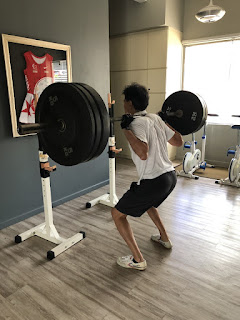 |
| Picture from Nike |
Better still if they can get a pair Kipchoge's prototype shoe dubbed the Alphafly that he wore during the sub 2 hour marathon in Vienna.
 |
| Picture from Nike |
If you compete in running races or support your friends or loved one at their races you will surely notice that ultra thick, super cushioned shoes are quite the norm now. This is different from the minimalist, barefoot style shoes that were popular just a few years ago.
Some runners definitely got hurt wearing the barely there, minimalist type running shoes, while others did not like the skimpy feel which probably contributed to the wide swing towards the maximalist running shoes that are popular now.
Running in these thickly cushioned shoes can affect running form in surprising ways as found by researchers on recreational athletes. As I wrote before in a previous post, these recreational runners pound harder and pronate more in thickly cushioned shoes compared to standard running shoes (Pollard et al, 2018).
In a follow up study to Pollard et al's study (2018), the researchers had the runners run in the maximalist shoes for six weeks (so the runners get used to them) before they repeated the testing.
The runners somehow did not adjust to the shoes. Interestingly, the runners still landed with greater force and pronated more in the maximalist shoes compared to their initial test run (Hannigan and Pollard, 2019).
There was a yet another follow up study which was just published last month on a new group of male and female recreational runners (Hannigan and Pollard, 2020). The researchers got New Balance to custom make a pair of their neutral running shoes to allow them to alter the shoe by adding or removing foam. This shoe can then serve as minimalist, traditional or maximalist shoes to allow the researchers to focus solely on the role of cushioning in the runners' form.
This time, a few of the runners in this study were found to land heavily in the minimalist and maximalist shoes, but they pronated most in the maximalist shoes.
The authors commented that looking at the three studies as a whole would suggest that extra cushioning does influence several aspects of the way we run. The thickly stacked soles of maximalist shoes seem to subtly affect balance, making the shoe more unstable. This is then likely to increase ankle movement and pronation.
With the extra layers of foam, it also affects the way our legs feel the ground when we land. This affects our muscles, brains and our nervous system in coordinating and anticipating foot fall when we walk or run.
Points to note are the researchers did not look at how fast the runners ran nor did they ask how the runners felt in the maximalist shoes. They also did not track actual running injuries in the runners studied so they cannot say if the extra cushioning contributes to or reduces injury.
Even though I have treated runners who have gotten seriously injured while wearing maximalist running shoes, I'm definitely not against any runners switching to them. Provided they have tested them and ease into training with them slowly and finding them suitable.
Reading the 3 articles and interpreting their results has made me wonder if the thicker soled models are right for recreational runners since comfort and injury risks are different compared to elite runners.
*Note -In the 2018 and 2019 running studies, the runners wore Hoka running shoes and not the Nike Vaporfly.
References
Hannigan JJ and Pollard CD (2019). A 6-Week Transition To Maximal Running Shoes Does Not Change Running Biomechanics. AJSM. 47(4): 968-973. DOI: 10.1177/0363546519826086.
Hannigan JJ and Pollard CD (2020). Differences In Running Biomechanics Between A Maximal, Traditional And Minimal Running Shoe. J Sci Med Sp. 23(1): 15-19. DOI: 10.1016/j.jsams.2019.08.008
Pollard CD Ter Har JA et al (2018). Influence Of Maximal Running Shoes On Biomechanics Before And After A 5k Run. Orth J Sp Med. 6(6): 2325967118775720. DOI: 10.1177/2325967118775720.















